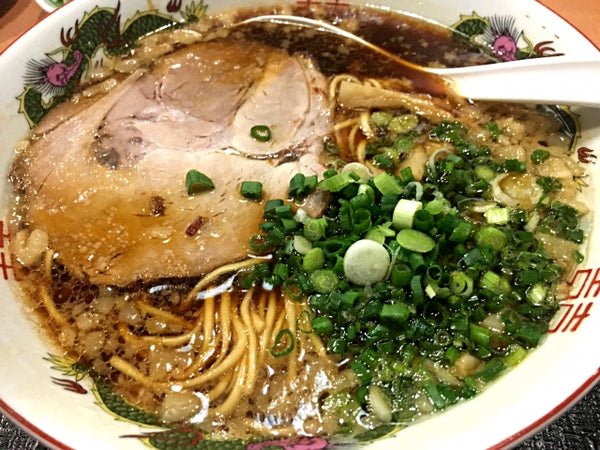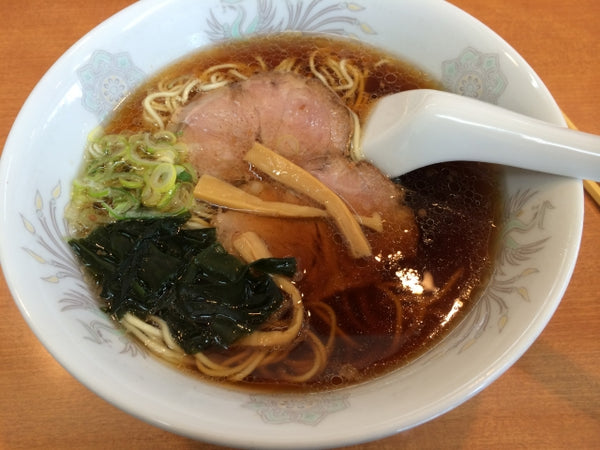Regional Ramen: A Trip Across Japan

The regional ramen of Japan, known as gotōchi ramen, are a shining example of how one can travel through food. Across the 47 prefectures of Japan you’ll find local styles that transform the dish into something unique.
With varying broth, tare, noodles, and toppings, here are ten noteworthy regional styles of ramen found in Japan:

Sapporo Ramen—Style: Miso
Invented in 1955 in the city of Sapporo in Hokkaidō, Japan's northernmost main island, Sapporo ramen is thought to be the origin of miso ramen. It is a combination of miso tare and tonkotsu broth that creates a creamy soup for the curly, yellow noodles to nestle in. Toppings generally include chashu (pork), menma (bamboo shoots), negi (green onions), bean sprouts, ginger, garlic and two oddball ingredients unique to the region: corn and butter.

Hakodate Ramen—Style: Shio
With a lighter chicken and pork-based broth seasoned with salt and herbs, Hakodate ramen is thought to be the original shio ramen. It is usually served with medium to thin straight noodles and has a cleaner flavor than other styles which allows the broth to shine, complementing the common toppings of menma, chashu, negi, spinach, corn, and kamaboko (fish cake).

Asahikawa Ramen—Style: Shōyu
Rounding out the trio of Hokkaidō ramen styles, Asahikawa ramen first began in 1947 in Asahikawa, Hokkaidō’s second largest city. It combines a chicken and pork-based stock with a seafood broth and shōyu tare (soy sauce seasoning), thought to be the origin of the blended “double” soup style popular in Japanese ramen. The signature toppings include menma, chashu, negi and a liberal scoop of melted lard, meant to insulate the bowl of ramen in the frigid Hokkaidō winters.

Kitakata Ramen—Style: Shōyu
Hailing from the city with the highest ramen restaurant-to-resident ratio, Kitakata ramen is a shōyu-based ramen from northern Fukushima. The simple, clear soy sauce broth can be seasoned with tonkotsu (pork broth), niboshi (baby sardines), chicken, and other ingredients, but is often accompanied by thick, hand-cut wavy noodles and chashu, negi, menma, and kamaboko.

Hakata Ramen—Style: Tonkotsu
Originating in Fukuoka in southern Japan, Hakata ramen is one of the most popular regional varieties. The straight, thin noodles and umami rich silky tonkotsu broth are paired with chashu, kikurage (wood-ear mushrooms), takana (pickled mustard greens), pickled ginger, negi, sesame seeds, and crushed ginger, many of which appear as table condiments.

Wakayama Ramen—Style: Tonkotsu-Shōyu
Also known locally as chuka soba, Wakayama ramen is based around a strong shōyu tare and a thick tonkotsu broth, highlighting the trend of western Japanese ramen to be dominated by rich, porky broths. This salty, rich ramen style uses straight, thin noodles and is often topped with menma, chashu, negi, and kamaboko.

Onomichi Ramen—Style: Shōyu
Onomichi is a small town in Hiroshima and the regional style of ramen emerged after World War II as a distinct break from other styles. The broth is made from a shōyu base combined with chicken, some pork bones, and local seafood, but what really sets it apart is the thick layer of melted lard that is poured over the top, suspending the chashu, negi, and menma in porky goodness.

Kagoshima Ramen—Style: Tonkotsu-Shōyu
Particularly distinct with its lighter shōyu (soy sauce), pork, chicken, niboshi, shiitake, and vegetable broth, which is usually finished off with scorched onions, Kagoshima ramen shows influences from Okinawa and Taiwan in the variety of noodle thickness found throughout the city. It is also well known for their chashu made from a local type of pig, which goes well with the usual negi, kikurage, and bean sprouts.

Kurume Ramen—Style: Tonkotsu
There have been few cities in Japan that have had as much of an influence on ramen history than Kurume in Kyūshū has. Predating the influential Hakata style, Kurume ramen established the local tradition of strong, creamy tonkotsu broths that Kyūshū is known for. It all began with an accident back in 1947 when a pot of pork bones was left to boil for too long on too high a heat, unknowingly creating the marrow-rich broth that would spread across the region. Kurume ramen tends to be pungent and punchy with bits of fried lard and melted marrow glistening around chashu, negi, nori, takana, sesame seeds, pickled ginger, and garlic.

Tōkyō Ramen—Style: Shōyu
The number of ramen restaurants and styles of ramen found throughout Tōkyō is staggering, but the “original” Tōkyō ramen is a blended broth of shōyu, chicken, pork, veggies, kombu (kelp), katsuobushi (bonito/skipjack tuna flakes), and niboshi. It is probably the most recognizable style with its complex, dark soup and thick curly noodles, all supported by a host of toppings usually including chashu, menma, kamaboko, nori (seaweed), spinach, and a hanjuku tamago (soft boiled egg).
While that might be the traditional Tōkyō ramen, there is another style born in the city as well: tsukemen. More a different approach to ramen than a regional style, tsukemen is a dish where the noodles are served separately, cold and undressed, and are meant to be dipped into a bowl of thick, undiluted broth. The broths vary wildly, but the original tsukemen tare created by the inventor himself, the “God of Ramen” Kazuo Yamagishi, is sweet, spicy, fishy, and tangy, clinging perfectly to the extra thick noodles as you slurp them up.
As one can see, the regional styles of ramen in Japan can make for a special trip all their own. And there are plenty more than the ones listed here, so if you have a passion for ramen you might consider planning a trip to travel from one prefecture to the next in search of a different bowl of noodles to slurp!

About the author: The spark that lit Kevin Kilcoyne’s interest in Japanese culture began in elementary school through a friendship with his then classmate Keisuke. Since then, that passion has evolved and bloomed to encompass more than just video games and manga, leading Kevin to live in Japan as a participant of the JET program. During his time in Japan, Kevin sought out as many foods as he could, the experiences and taste memories lingering long after they had gone. Now he is forging a path to link his passions for Japanese food, history, and visual culture and is planning for his return to live in Japan once again. For now, you can find Kevin on Instagram (@waruishouten) where he posts his photography and illustration work. Keep an eye out for more posts and updates as Kevin delves more deeply into his passions for writing and food!




